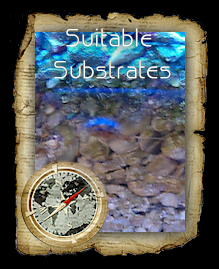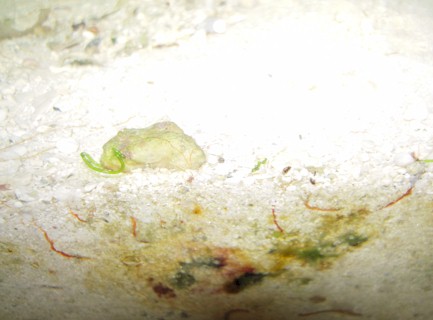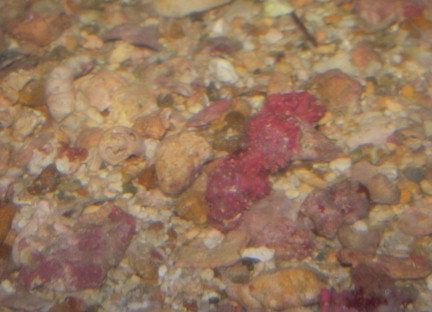|
 There
are many suitable substrates for growing marine plants in the
aquarium. The composition, depth and size of the substrate used
is largely based on the individual species of macro algae or sea
grass desired. Many commercial products are available to hobbyists
for use with marine plants, but most are marketed for the refugium.
Although macro algae does not derive any nutrients directly form
the substrate, with the exception of sea grass, some type of
substrate is usually needed for most species so that they can
readily attach themselves. By far, the most popular substrate is the use
of a fine grade aragonite sand at varying depths of up to 6” or
more. Fine grade sand is readily colonized by most all Caulerpa
species and is generally the easiest to maintain. There are also
proven benefits to providing a deep sand bed to reduce nitrates
and to culture marine fauna, but macro algae only require about
1” or less to attach and grow. Sea grass, however, does require a
deep sand bed as its root system can extend quite deep, as much as
12”. There
are many suitable substrates for growing marine plants in the
aquarium. The composition, depth and size of the substrate used
is largely based on the individual species of macro algae or sea
grass desired. Many commercial products are available to hobbyists
for use with marine plants, but most are marketed for the refugium.
Although macro algae does not derive any nutrients directly form
the substrate, with the exception of sea grass, some type of
substrate is usually needed for most species so that they can
readily attach themselves. By far, the most popular substrate is the use
of a fine grade aragonite sand at varying depths of up to 6” or
more. Fine grade sand is readily colonized by most all Caulerpa
species and is generally the easiest to maintain. There are also
proven benefits to providing a deep sand bed to reduce nitrates
and to culture marine fauna, but macro algae only require about
1” or less to attach and grow. Sea grass, however, does require a
deep sand bed as its root system can extend quite deep, as much as
12”.
 Careful
attention should be taken to not introduce substrate to the
aquarium that is too compacted, such as silica or quartz sand as
this will most likely cause a dense anaerobic layer in the sand bed
that can be toxic to tank inhabitants if disturbed. If a mixed
macro algae and sea grass system is desired, it would need to
devote some portion of the aquarium to a deep sand bed in order to
successfully grow vascular plants. For the most part, a mixture of
substrates will create an environment suitable for the addition of
most any species desired.
Most commonly
available substrates are composed of variable amounts of aragonite
and/or calcite. Aragonite is beneficial in its ability to
properly buffer the aquarium water, helping to maintain both ph
and alkalinity. Smaller grain sizes dissolve faster while coarse
media such as crushed coral is much slower to break down requiring
a higher ph to dissolve. Marine plants that do well in a fine to
medium grade aragonite sand include most species of Caulerpa and
calcified algae such as shaving brush & mermaids fan, as well
as sea grass. Careful
attention should be taken to not introduce substrate to the
aquarium that is too compacted, such as silica or quartz sand as
this will most likely cause a dense anaerobic layer in the sand bed
that can be toxic to tank inhabitants if disturbed. If a mixed
macro algae and sea grass system is desired, it would need to
devote some portion of the aquarium to a deep sand bed in order to
successfully grow vascular plants. For the most part, a mixture of
substrates will create an environment suitable for the addition of
most any species desired.
Most commonly
available substrates are composed of variable amounts of aragonite
and/or calcite. Aragonite is beneficial in its ability to
properly buffer the aquarium water, helping to maintain both ph
and alkalinity. Smaller grain sizes dissolve faster while coarse
media such as crushed coral is much slower to break down requiring
a higher ph to dissolve. Marine plants that do well in a fine to
medium grade aragonite sand include most species of Caulerpa and
calcified algae such as shaving brush & mermaids fan, as well
as sea grass.
Coarse
media such as crushed coral, shell or live rock rubble can also be
used to anchor marine plants and is a good choice if a deep sand
bed is not needed, especially in the refugium. The only drawback
to using coarse sand/rubble is that it tends to collect detritus
and sediment, often becoming a nutrient trap over time. In marine
plant dominated aquariums this can be an added benefit however, as
high levels of nutrients are needed for long term success. Some
invertebrates are better suited to this environment, such as
amphipods, while other soft bodied invertebrates desire a less
abrasive environment.  Most varieties of red and brown macro algae
grow on rocks and hard bottom habitats in their natural
environment, so a coarser substrate is more suited for anchoring.
Marine macro algae such as Gracilaria, Botryolcadia, Sargassum and
Halymenia can be glued or placed between rocks/rubble and will
readily attach themselves. Most
all macro algae are very adaptable, and will grow free
floating or attach to most any surface, including substrate, live
rock or even the sides or bottom of aquariums. Most varieties of red and brown macro algae
grow on rocks and hard bottom habitats in their natural
environment, so a coarser substrate is more suited for anchoring.
Marine macro algae such as Gracilaria, Botryolcadia, Sargassum and
Halymenia can be glued or placed between rocks/rubble and will
readily attach themselves. Most
all macro algae are very adaptable, and will grow free
floating or attach to most any surface, including substrate, live
rock or even the sides or bottom of aquariums.
During
the early 1990’s, mud filters began to gain in popularity for use
in the refugium. Several manufacturers began offering a product
that would duplicate tropical coastal environments, such as
lagoons and mangrove habitats. These products claim to provide a
variety of trace elements including, calcium, iodine, strontium,
iron, and free carbon. The idea behind the “mud” was to
provide a replenishing source of nutrients by slowly releasing
them into the aquarium water. Below
is a brief summary detailing the most popular aquarium mud, its composition
and qualities.
Miracle
Mud Manufactured
by Ecosystems Aquarium Inc., this substrate is light tan in color
with a wide range of grain sizes. The composition is very silty
and must be topped with aragonite so as not to disturb the
substrate. The manufacturer claims that this product contains over
68 naturally occuring elements. The replacement of approximately
50% of the substrate should be done every 12 months to maintain
the slow release of nutrients. Mineral
Mud Manufactured
by CaribSea Inc., this substrate is a dark brown almost black mud
which includes a mix of grain sizes including large chunks of
sediment. This particular product is very silty and must be topped
with aragonite or similar product to prevent it from clouding the
aquarium water. The manufacturer claims that it contains simply
"marine organics" created to mimic coastal marine
environments. Fiji
Mud Refugium Booster Manufactured
by Walt Smith International Inc., this substrate is a wild
collected organic mix harvested from Fiji. It is dark brown in
composition and is designed to be topped with aragonite or similar
product. No ingredients are listed except that it is deep
water mud from Fiji. F.O.R.M Manufactured
by Marc Weiss. F.O.R.M (funky old reef mud) is actually a additive
that is added to the refugium to release needed nutrients. This
particular product is a dark rich highly organic material derived
from the ferment of seaweed. Marine
Biosediment Manufactured
by Kent Marine Inc., this substrate is a fine aragonite based sand
containing calcium, magnesium, strontium, potassium, carbonate,
sulfate and other trace elements.
|